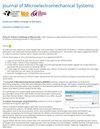一种高性能机械耦合四重呼吸模环谐振器
IF 3.1
3区 工程技术
Q2 ENGINEERING, ELECTRICAL & ELECTRONIC
引用次数: 0
摘要
本文报道了一种机械耦合四重呼吸模式环(QBR)谐振器,其中四个相同的环位于方形板的四个角,具有适当的设计,以实现良好的机械耦合。耦合QBR谐振器通过对分布在环内和环周围的电极施加静电力,以方形伸展-耦合呼吸环(SE - BR)模式振动。测量结果表明,所制备的耦合QBR谐振器在10.12 MHz谐振频率下具有高品质因子($\boldsymbol {Q}$)为322,110,低运动阻抗为18.12 k $\Omega $。在整个工业温度范围(−40 ~ + 85~^{\circ} $ C)内,测量到的频移小于±67 ppm,其转换点接近室温。与独立的SE模式或BR谐振器相比,由于耦合QBR谐振器的大转导面积和SE模式谐振器作为核心耦合元件的优异频率-温度稳定性,所报道的耦合QBR谐振器具有显著的运动阻抗降低和优越的频率-温度稳定性。由于其良好的性能,耦合QBR谐振器在温度补偿MEMS振荡器(TCMOs)领域具有广阔的应用前景。(2025 - 0054)本文章由计算机程序翻译,如有差异,请以英文原文为准。
A High-Performance Mechanically Coupled Quadruple Breathing Mode Ring Resonator
This letter reports a mechanically coupled quadruple breathing mode ring (QBR) resonator, in which four identical rings are located at the four corners of a square plate with proper design for achieving favorable mechanical coupling. The coupled QBR resonator is purposely designed and forced into vibrating in a square extensional (SE)-coupled-breathing ring (BR) mode by applying electrostatic forces to the electrodes distributed both within and surrounding the rings. Measurement results illustrate that the fabricated coupled QBR resonator has a high quality factor ( $\boldsymbol {Q}$ ) of 322,110 and a low motional impedance of 18.12 k $\Omega $ at its resonant frequency of 10.12 MHz. The measured frequency shift is less than ±67 ppm over the entire industrial temperature range of −40 to $+ 85~^{\circ } $ C, with a turnover point near room temperature. Compared with a standalone SE mode or BR resonator, the reported coupled QBR resonator demonstrates a notable reduction in motional impedance and superior frequency-temperature stability, thanks to the large transduction area of the coupled QBR resonator and the excellent frequency-temperature stability of the SE mode resonator as the core coupling element. In light of its decent performance, the coupled QBR resonator has promising application prospects in the field of temperature-compensated MEMS oscillators (TCMOs). [2025-0054]
求助全文
通过发布文献求助,成功后即可免费获取论文全文。
去求助
来源期刊

Journal of Microelectromechanical Systems
工程技术-工程:电子与电气
CiteScore
6.20
自引率
7.40%
发文量
115
审稿时长
7.5 months
期刊介绍:
The topics of interest include, but are not limited to: devices ranging in size from microns to millimeters, IC-compatible fabrication techniques, other fabrication techniques, measurement of micro phenomena, theoretical results, new materials and designs, micro actuators, micro robots, micro batteries, bearings, wear, reliability, electrical interconnections, micro telemanipulation, and standards appropriate to MEMS. Application examples and application oriented devices in fluidics, optics, bio-medical engineering, etc., are also of central interest.
 求助内容:
求助内容: 应助结果提醒方式:
应助结果提醒方式:


